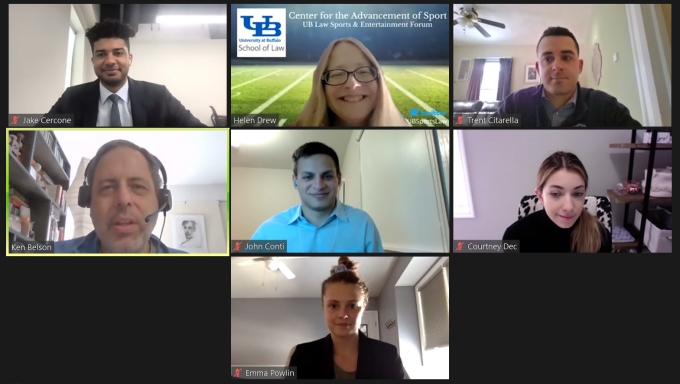
Sharing the inside scoop on the NFL
The business of America’s favorite sport—and the business of covering it for America’s premier newspaper—were on the table at a lively pre-Super Bowl webinar called “View From the Sidelines: The Business and Politics of the NFL."

NFL correspondent, Ken Belson
The Feb. 4 event featured Ken Belson, NFL correspondent for The New York Times. It was sponsored by UB’s Center for the Advancement of Sport and the UB and UB Law alumni associations, and moderated by Professor Helen “Nellie” Drew '88, who directs the interdisciplinary center. “It was quite a treat for my Sports Law II students,” says Drew, “particularly as many classes remain online this semester.”
Belson, a New York Times sports reporter since 2006, covers the NFL from a variety of angles, including teams, stadiums, medical issues and lawsuits. He previously covered general business issues for the New York Times, including three years in the newspaper’s Tokyo bureau.
Many players would rather talk to ESPN, Belson said, but the paper’s reputation sometimes opens the door to good stories. He told of his interview with Denver Broncos guard John Moffitt, who abruptly retired in 2013 with an announcement on Twitter. “This is weird,” Belson said. “Who retires like this?” He tried contacting the elusive player, and luck was with him: a night editor from Moffitt’s hometown knew his father. Belson called and the father said, “My son John has been waiting for you to call him. He only wants to talk to The New York Times.” John Moffit told him, “I knew you’d take me at face value and not portray me as a jock or an injured player—you would try to listen to my whole story.”
Belson has written extensively about the NFL’s response to player concussions. “They deserve credit for confronting the problem,” he said. “It had gotten quite bad.” Now the league has added neuropsychologists and other doctors, as well as spotters who watch from the press box with binoculars at every game, looking for players showing signs of concussion. It has also introduced rule changes, including mitigating one of the most dangerous plays in the game—the kickoff—by moving the line of scrimmage forward, and limiting the number of full-contact practice sessions.
“The league is trying to balance player safety and health, and make sure that star players don’t disappear when they’re needed,” Belson said. Fans by now are familiar with the NFL’s concussion protocol, a five-step recovery process that can be completed in a week. But, he said, “my cynicism tells me that seven days is a very convenient number of days.”
In response to a student’s question about pandemic limits on fans in stadiums, Belson said the league hasn’t been severely hurt economically. “The NFL, more than any other sports league, is the most able to withstand the absence of fans. The other leagues are much more exposed to empty stadiums financially,” he said.
Three-quarters of the league’s overall revenue, he explained, comes from its television contract along with national sponsorships and marketing and merchandise deals. “Even before they turn on the lights,” he said, “the Buffalo Bills have enough to cover their payroll for the year.” And the optics of packed stadiums in an era of social distancing have been crucial: “I think they realized it would look completely destructive and not prudent to have stadiums full of fans.”
Though the NFL is his beat, Belson said he most enjoys reporting farther afield. “I did a series of stories on youth football in Texas,” he said. “I learned a ton and met really good people, just dads raising sons who want to play good football, coaches, trainers, principals. It felt like America, and it felt like real people.”